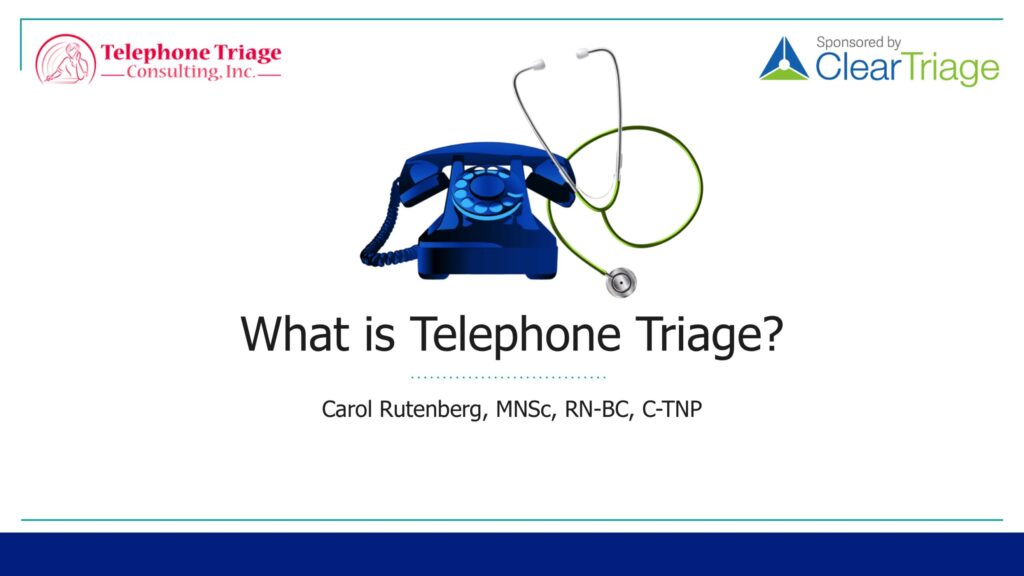A transcript taken from Carol Rutenberg’s video What is Telephone Triage?
Telehealth nurses use a variety of different types of modalities to provide care remotely. Under that umbrella of telehealth nursing, nurses utilize remote monitoring equipment such as blood pressure devices and cardiac monitors (eg. to track the progress of a patient with congestive heart failure). The nurses track patients that have the “I’ve fallen and can’t get up” buttons, and then of course there’s always email. Patients either emailing you directly or using the patient portal can contact you for a variety of reasons.
Then of course there’s always the ever-present telephone. Under that more narrow umbrella of telephone nursing fall a variety of different call types that require management by a registered nurse. It’s helpful to note that while not every call is a telephone triage call every call has the potential to require telephone triage. The key distinction is whether or not the call is symptom-based.
SYMPTOM-BASED AND TIME SENSITIVE
Although there are different types of calls, for our purposes I’d like to divide them into two broad categories. Either they’re triage calls or they’re not. Triage calls are simple to identify in that in addition to being symptom-based they’re also time sensitive, meaning the patient could experience a significant delay in care if calls aren’t managed promptly.
The primary objective of the telephone triage nurse is to identify the nature and urgency of the patient’s problem and direct them to the appropriate level of care, providing support and collaboration as necessary along the way. These patients don’t yet have a diagnosis. Even if they’ve been evaluated previously that day face to face or over the phone, each call must be addressed as a new call in order to identify problems that were initially overlooked or that have evolved since the last contact.
All other nurse patient calls for the purposes of this presentation are non-triage. These calls, while important and certainly requiring the nurse’s professional judgment, are usually not time sensitive and they address patient management issues that reflect the patient’s existing plan of care.
AAACN DESCRIPTION & DEFINITION
The American Academy of Ambulatory Care Nursing or AAACN has adopted the following description and definition of telephone triage.
The description: “Telephone triage is a component of telephone nursing practice that focuses on assessment, prioritization, and referral to the appropriate level of care.” It’s defined as “an interactive process between nursing and client that occurs over the telephone and involves identifying the nature and urgency of client healthcare needs and determining the appropriate disposition”. Key elements of note are assessment, prioritization, and referral to the appropriate level of care.
Interestingly, although RNs don’t diagnose according to the definition we do identify the nature and urgency of the patient’s problem. That process requires diagnostic reasoning, a topic for another day and time. One thing is clear however, telephone triage requires sophisticated critical thinking that utilizes diagnostic reasoning and is a high risk form of care – especially if the nurse takes the encounter lightly.
AAACN specifies that we are to refer the patient to the appropriate level of care. Although some research indicates that in determining an appropriate referral nurses balance risk against appropriate utilization of resources, we must remember that while being cost-effective is imperative in all forms of care, the most cost-effective strategy available to us is to above all provide safe care.
Callers regarding the nurses authority will often forsake their own common sense to follow instructions of the nurse. Remember the patient is somebody’s somebody and they’re depending on us to get it right.
Carol Rutenberg is a nationally recognized expert and speaker in the field of telephone triage. To learn more from Carol about the ideas in this video, you can refer to The Art and Science of Telephone Triage written by Carol and her colleague Liz Greenberg and endorsed by the American Academy of Ambulatory Care Nursing. This video training series was produced and sponsored by ClearTriage, an online version of the Schmitt-Thompson telephone triage protocols that is compatible with Carol’s teachings and widely used as a decision support tool for telephone triage nurses and practices and clinics.
Carol’s training is also the basis for the American Academy of Ambulatory Care Nursing’s Telephone Triage Course which is available for purchase and eligible for 17.5 continuing education hours.
ClearTriage is a web-based decision support tool for telephone triage nurses and the leading provider of the Schmitt-Thompson telephone triage protocols. ClearTriage offers several technical integrations including SSO, embedding, structured data return, and translation. Contact us to learn more or start your 30-day free trial today.

